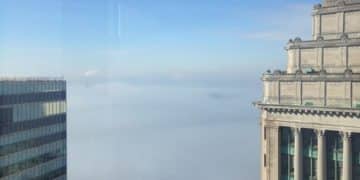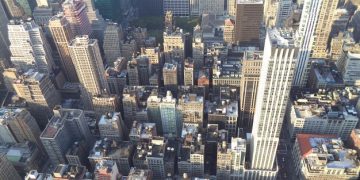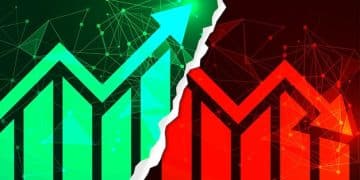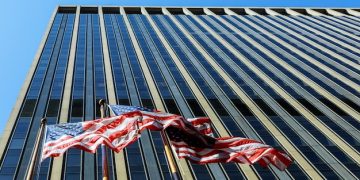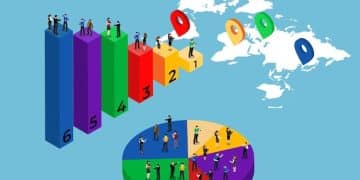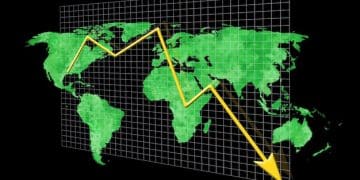US Federal Reserve Rate Hikes: Impact on Global Capital Flows
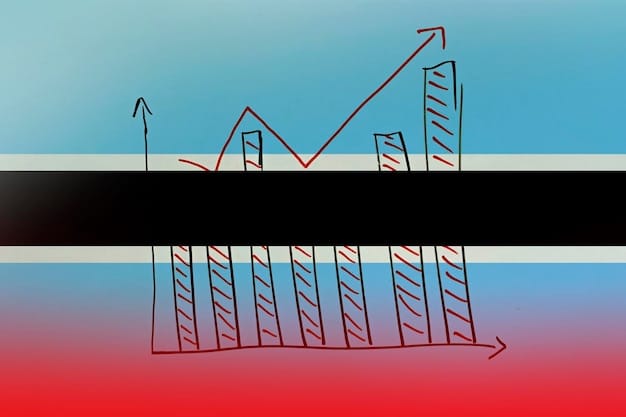
Understanding the Implications of the US Federal Reserve’s Interest Rate Hikes on Global Capital Flows involves analyzing how increased interest rates in the US can redirect investment, affect exchange rates, and influence economic stability worldwide.
The implications of the US Federal Reserve’s Interest Rate Hikes on Global Capital Flows are far-reaching, influencing investment strategies and economic stability worldwide. As the Fed adjusts interest rates, global markets respond, creating both opportunities and challenges for investors and policymakers alike.
Understanding the Federal Reserve’s Monetary Policy
The Federal Reserve (commonly referred to as the Fed) plays a pivotal role in shaping the US economy through its monetary policy. These policies, especially adjustments to interest rates, have profound effects that extend beyond the nation’s borders.
The Role of Interest Rates
Interest rates are a key instrument used by the Fed to manage inflation and promote economic stability. When the Fed raises interest rates, it becomes more expensive for businesses and individuals to borrow money, which can slow down economic activity.
How the Fed Sets Interest Rates
The Federal Open Market Committee (FOMC) is responsible for setting the federal funds rate, influencing other interest rates throughout the economy. Decisions are made based on economic data, forecasts, and assessments of risks to the economy.
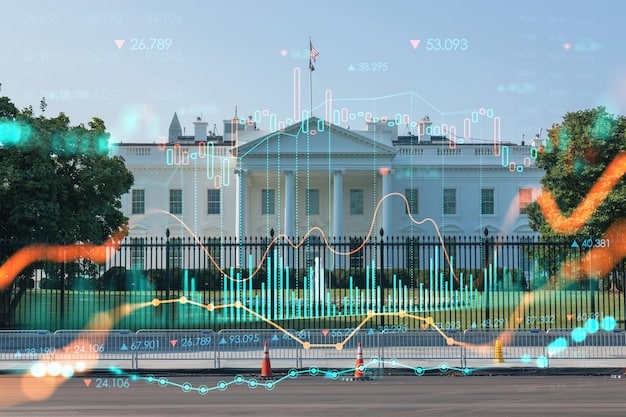
Understanding how the Fed’s monetary policy works helps comprehend the ripple effects of interest rate hikes on global capital flows. When rates rise, it impacts everything from investment decisions to currency values.
Let’s delve into the specifics:
- Impact on Borrowing: Increased rates mean higher costs for loans, affecting both businesses and consumers.
- Influence on Spending: With borrowing more expensive, spending tends to decrease, cooling down the economy.
- Role in Inflation Control: Higher interest rates can help curb inflation by reducing the money supply.
In summary, the Federal Reserve’s monetary policy, particularly its control over interest rates, is a powerful tool with extensive consequences for the global economy, especially concerning capital flows.
The Mechanics of Global Capital Flows
Global capital flows refer to the movement of money between countries, driven by investment, trade, and financial activities. These flows are crucial for economic growth and stability, influencing exchange rates, interest rates, and asset prices globally.
Factors Influencing Capital Flows
Several factors drive global capital flows, including economic growth prospects, interest rate differentials, political stability, and investor sentiment. Higher returns and lower risks attract capital, while uncertainty and instability can deter it.
Types of Capital Flows
Capital flows can be categorized into foreign direct investment (FDI), portfolio investment, and other investments. FDI involves long-term investment in productive assets, while portfolio investment includes stocks and bonds.
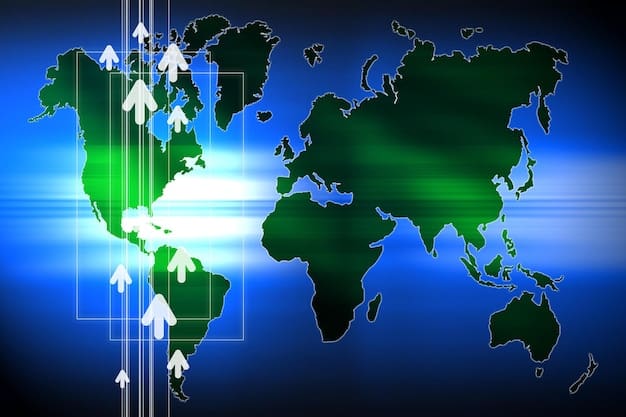
Understanding the mechanics of global capital flows is essential to grasp the implications of the Fed’s actions. When the Fed raises interest rates, it creates a ripple effect that touches various aspects of the global economy.
Consider these key points:
- Impact on Exchange Rates: Changes in capital flows can lead to fluctuations in exchange rates.
- Influence on Investment: Capital flows affect where and how investments are made worldwide.
- Role in Economic Growth: Capital inflows can stimulate economic growth, while outflows can hinder it.
- Effects on Asset Prices: Increase in capital flow influence the prices of assets, such as property value.
In essence, global capital flows are a complex interplay of economic and financial forces that have significant implications for national economies.
Immediate Effects of US Rate Hikes
When the US Federal Reserve increases interest rates, the immediate effects are felt across financial markets worldwide. The attractiveness of US assets increases, leading to significant shifts in global capital flows.
Increased Attractiveness of US Assets
Higher interest rates in the US make dollar-denominated assets more appealing to investors. Bonds, savings accounts, and other investments offer higher returns, enticing global investors to move their capital into the US.
Strengthening of the US Dollar
As demand for US assets rises, so does the demand for the US dollar. This increased demand can lead to the appreciation of the dollar against other currencies, making US exports more expensive and imports cheaper.
The immediate effects of US rate hikes are significant, influencing investment decisions and currency values. It’s crucial to understand that these changes happen almost in real-time, affecting economies worldwide.
Here’s a scenario to consider:
- Investment Shift: Global investors reallocate their portfolios to take advantage of higher US interest rates.
- Dollar Appreciation: The US dollar becomes stronger, impacting international trade and finance.
- Market Reactions: Stock markets and bond markets react to the changes, creating both opportunities and risks.
In summary, the initial reactions to US interest rate hikes involve a shift in investment towards US assets and a strengthening of the dollar, setting off a chain of economic events.
Impact on Emerging Markets
Emerging markets often face challenges when the US Federal Reserve raises interest rates. These economies are particularly vulnerable to shifts in capital flows and changes in investor sentiment.
Capital Outflows
Higher interest rates in the US can lead to capital outflows from emerging markets. Investors seek higher returns and safer assets in the US, pulling their investments out of emerging economies.
Increased Borrowing Costs
Emerging markets that have dollar-denominated debt face increased borrowing costs when the dollar strengthens. Servicing this debt becomes more expensive, potentially leading to financial strain.
The impact on emerging markets can be severe, affecting their economic growth and stability. Understanding these vulnerabilities is crucial for policymakers and investors alike.
Several factors contribute to this impact:
- Debt Burden: Many emerging markets have significant dollar-denominated debt, making them vulnerable to currency fluctuations.
- Investment Climate: Capital outflows can disrupt investment plans and slow down economic growth.
- Policy Responses: Emerging markets may need to raise their own interest rates to attract capital, which can further dampen economic activity.
In conclusion, US rate hikes often create headwinds for emerging markets, including capital outflows and higher borrowing costs, highlighting the interconnectedness of the global financial system.
Long-Term Consequences for Global Trade
The long-term consequences of US Federal Reserve rate hikes extend to global trade, altering the competitiveness of nations and reshaping trading relationships. These effects can be complex and far-reaching.
Shift in Trade Balances
A stronger US dollar makes US exports more expensive and imports cheaper, potentially leading to a shift in trade balances. Other countries may find it harder to compete with US goods and services.
Impact on Commodity Prices
Many commodities are priced in US dollars, so a stronger dollar can make these commodities more expensive for countries with weaker currencies. This can affect commodity-exporting nations and global supply chains.
Understanding the long-term consequences for global trade helps appreciate the extensive reach of US monetary policy. Trade dynamics can change significantly, affecting economies large and small.
Here are some key considerations:
- Export Competitiveness: The strength of the dollar affects the ability of US companies to compete in international markets.
- Import Costs: A stronger dollar reduces the cost of imports, benefiting US consumers and businesses that rely on imported goods.
- Trade Relationships: Changes in trade balances can strain relationships between trading partners, leading to trade disputes and policy adjustments.
The long-term effects on global trade involve shifts in competitiveness, altered commodity prices, and potential strains on trade relationships, underlining the interconnectedness of global economies.
Strategies for Investors and Policymakers
In the face of US Federal Reserve rate hikes, both investors and policymakers need to adopt strategies to navigate the changing economic landscape. Proactive measures can help mitigate risks and capitalize on opportunities.
Diversification of Investments
Investors can diversify their portfolios to reduce exposure to US assets and mitigate the impact of currency fluctuations. Investing in a mix of asset classes and geographic regions can help cushion the blow from US rate hikes.
Prudent Fiscal Policies
Policymakers should implement prudent fiscal policies to maintain economic stability and attract foreign investment. Sound economic management and transparent governance can help instill confidence in investors.
Effective strategies for investors and policymakers are crucial for managing the impact of US rate hikes. They should focus on diversification, stability, and prudent financial management.
Key strategies include:
- Risk Management: Investors should assess their risk tolerance and adjust their portfolios accordingly.
- Currency Hedging: Companies and investors can use currency hedging to protect against exchange rate fluctuations.
- Policy Coordination: International cooperation and policy coordination can help stabilize global markets and reduce the impact of US rate hikes.
In summary, proactive strategies for investors and sound fiscal policies by governments are essential for navigating and mitigating the effects of US Federal Reserve rate hikes on global capital flows.
| Key Point | Brief Description |
|---|---|
| 📈 US Rate Hikes | Increase attractiveness of US assets, leading to capital inflows. |
| 💲 Stronger USD | Appreciates against other currencies, affecting trade balances. |
| 📉 Emerging Markets | Face capital outflows & higher borrowing costs. |
| 🌍 Global Trade | Experiences shifts in competitiveness. |
Frequently Asked Questions
▼
Capital flows are the movement of money for investment, trade, or business production between countries. These flows can influence exchange rates, interest rates, and overall economic stability.
▼
US rate hikes typically cause the dollar to strengthen. Higher interest rates attract foreign investment, increasing demand for the dollar and driving up its value compared to other currencies.
▼
Emerging markets often suffer due to capital outflows. Investors seek higher and safer returns in the US, pulling money from these markets and increasing borrowing costs.
▼
The FOMC, or Federal Open Market Committee, is the body within the Federal Reserve that sets monetary policy. It sets the federal funds rate, influencing interest rates throughout the economy.
▼
Investors can prepare by diversifying their portfolios to mitigate the impact. Risk management and currency hedging are tools that help navigate economic shifts due to US rate hikes.
Conclusion
In conclusion, understanding the implications of the US Federal Reserve’s Interest Rate Hikes on Global Capital Flows is vital for investors and policymakers alike. The interconnectedness of global economies means that changes in US monetary policy have far-reaching effects, influencing investment decisions, currency values, and economic stability worldwide. By implementing prudent strategies and maintaining a watchful eye on market dynamics, stakeholders can navigate these changes effectively.
